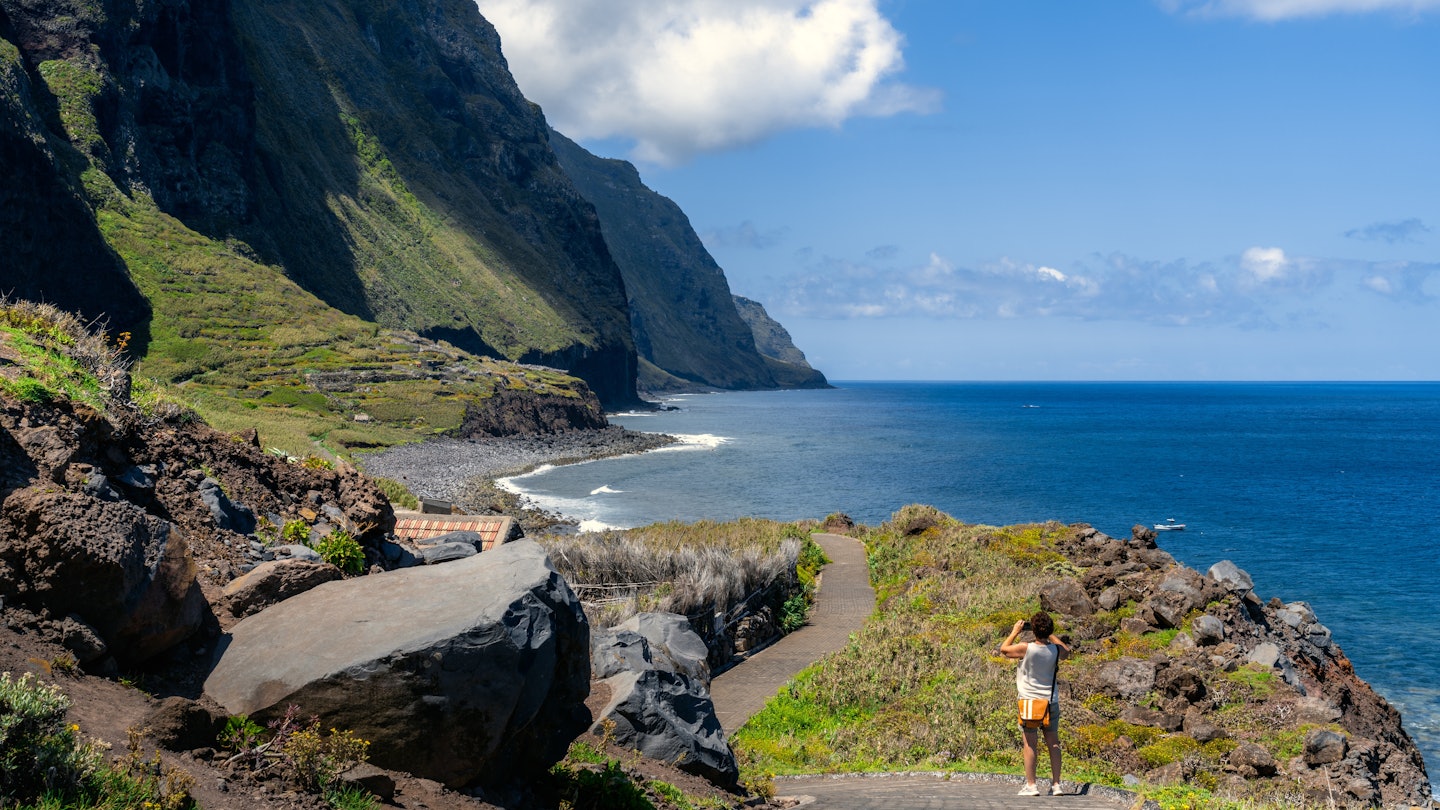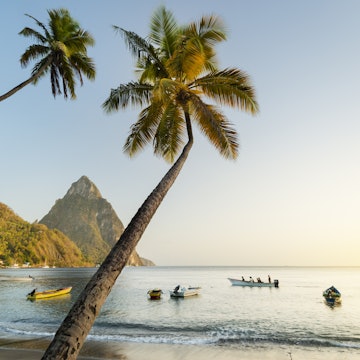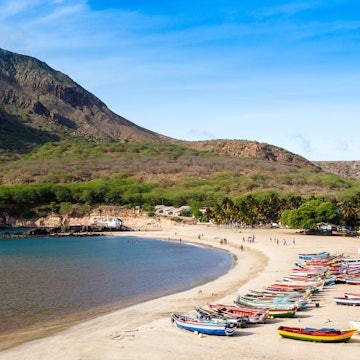

The views from Santa Maria Madalena, Madeira. Photosbypatrik/Shutterstock
The magical island of Madeira is an autonomous region of Portugal, yet lies closer to the coast of Africa than to the Algarve. Needless to say, it has its own unique identity.
On this rugged and subtropical island, both tropical fruit and grapes for legendary wine grow. Remote mountain villages sit in the interior, with fabulous seaside resorts along the coast. Misty forests give way to rocky beaches.
It’s the kind of place that makes your head spin. In the best possible way.
In particular, Madeira has much to offer independent and intrepid travelers. Active types will enjoy chances to swim, dive, surf and hike, with options that are both accessible and available for all levels of fitness and expertise. And a unique and delicious food and drink scene awaits you between pursuits.
If you’re traveling to Madeira for the first time...lucky you. Here’s all you need to know before your trip.

When should I go to Madeira?
Madeira is blessed with a subtropical climate, and the island experiences an average annual temperature of 70°F (21°C).
January sees the most rainfall, while the waters surrounding the island are at their warmest in September. If you're seeking peace and quiet, you may want to avoid the crush of tourists in August. Otherwise, Madeira is a great vacation option virtually any time of the year.

Is it easy to get to and around Madeira?
Madeira is linked to the world via Cristiano Ronaldo International Airport (yes, he’s a native of the island), a destination for flights from Europe and as well as from New York.
However, getting around the island is a bit more complicated. There is an extensive public bus transport system (Horários do Funchal serves the capital and its suburbs, while SIGA serves the entire island) – but if you want to hit the more remote corners for hiking routes or beaches, you’ll almost certainly need a car. Several car-rental companies have offices at the airport, but be warned that rates aren’t cheap.
Driving in Madeira has its challenges. The island is incredibly hilly, and its roads can be intimidatingly steep and winding. If you don’t feel confident driving in these circumstances, be sure to rent a car with an automatic transmission – you’ll pay a premium versus a manual mode, but one worth it in this case.
How much time should I spend in Madeira?
Because Madeira’s highlights are found at all over the island, you shouldn’t plan a stay of under four days. Consider a night in Funchal to get oriented, then supplement this with stops in one or two more destinations elsewhere on the island. Dedicate a day to active pursuits, followed ideally by a day to recover on the beach. Tack on at least another two nights if you plan to hit Porto Santo, the other inhabited island that forms part of the Madeiran archipelago.
Top things to do in Madeira

Hike a levada or a vereda
Nearly all of Madeira’s rain falls on the island’s north shore. So to facilitate agriculture on the island’s south, its early settlers created a series of man-made aqueducts known as levadas – some 804km (500 miles) of them, a feat of engineering recognized by UNESCO. Today, the island’s levadas, as well as its veredas (a general word for a path), double as hiking routes, which often traverse spectacular scenery and landscapes that include waterfalls, cliffs, lush forests and incredible viewpoints.

Meet your new travel partner
Unlimited data while you travel with Holafly eSIM. Use code LONELYPLANET for an exclusive discount.
Levadas exist in varying degrees of difficulty and repair; check out WalkMe, a regularly updated guide, to see if the levada you have in mind is open and safe.
A popular entry-level walk is the Levada do Caldeirão Verde, on the island’s west end. The hike consists of a relatively easy 11.8km (7.3 miles) round-trip, passing through diverse scenery that includes a lagoon and waterfall. Another popular walk with an entirely different feel is the Vereda da Ponta de São Lourenço, a 7.2km (4.4-mile) round-trip that tackles the island’s dry, rocky easternmost point and includes an opportunity for a refreshing dip in the ocean.
For those looking for more of a challenge, consider the trails that summit Pico do Areeiro and Pico Ruivo, the latter the island’s highest point, reached by a route that occasionally goes above the cloud line.

Ride a cable car
Madeira’s coast features numerous fajãs, areas backed by cliffs that were previously only accessible to boats. That is, until a series of cable cars were built. Originally used to shift goods and crops, today Madeira’s cable cars also transport tourists and day-trippers.
On the island’s northwest corner, the Teleférico das Achadas da Cruz is 600m (1970ft) long, lasts five minutes and is one of the steepest cable cars in Europe. The destination is a vast, crowd-free and rocky beach.
Also impressive is the cable car that descends to Fajã dos Padres, a rocky beach that is home to a farm and banana plantation, a cafe/restaurant and a dock for swimming.

Swim in a natural pool
The waters that surround Madeira have both an otherworldly azure hue and a temperature that makes them swimmable year-round. Unfortunately, the island’s rugged geography and stone beaches mean that accessing that water isn’t always easy. Thankfully, on a few different spots across the island, locals have taken advantage of lava outcroppings to sculpt oceanside swimming pools.
The most famous natural pool is in Porto Moniz, on the island’s northwestern corner – although with its extensive handrails, bathrooms and changing rooms, it doesn’t feel so natural these days. An even more dramatically positioned version can be found at Doca do Cavacas, on the island’s south shore. For something much more natural, consider the pools in Seixal or Cachalote, both of which also have the benefit of being free.

Taste fortified wine
Madeira’s eponymous wine was created when barrels of the stuff spent months on ships baking in the hot sun. This happy accident caused the wines to oxidize, giving them an entirely new and desirable set of flavors and aromas. Today, seven houses on Madeira make fortified wines in this style, nearly all of whom offer tours and tastings. HM Borges, in Funchal, was founded over a century ago and is one of the more traditional houses on the island; you can arrange a visit and tasting with advance notice. Barbeito is one of the more progressive houses and offers tastings daily.
Madeira was once the most important center of sugar production in the world, and six sugarcane mill-distilleries remain in operation on the island. (Indeed, it’s currently the only location in Europe that produces agricultural rum, distilled from sugarcane juice rather than from sugar or molasses.) North Mills Distillery, on the island’s north shore, is one of the only remaining steam-powered factories in Europe; contact the distillery in advance to arrange a visit and tasting. In the island’s south and dating to 1901, Engenho da Calheta offers tastings, and is also a good place to buy bolo de mel, Madeira’s signature sweet, which combines molasses, citrus juice, lard, Madeira wine and spices.
Much of the local rum makes its way into poncha, a drink that combines white rum, orange or lemon juice, and honey or sugar, all of which is then whipped with a special wooden tool into a frothy consistency. One of the most popular places for the drink is Taberna da Poncha, located in a mountain town in the island’s interior.

Visit a beach
Specifically, a rocky beach. Madeira’s particular geography and location mean that the island’s beaches consist exclusively of round stones. Buy a pair of aqua socks to traverse this relatively challenging terrain, and take note of the haunting roar of tens of thousands of rocks spinning and shifting with each wave.
If you want sand, head to the man-made beaches at Calheta or Machico, or take the ferry to Porto Santo, which has a 7.5km (4.6 miles) fine-sand beach that’s considered one of Europe’s best.
Eat an espetada
Madeira’s signature dish is espetada, chunks of beef marinated in garlic and bay leaves, skewered on a laurel branch or metal skewer and grilled. When served, the skewers arrive hung from unique contraptions. Diners pair them with bolo do caco, a type of bread made in part with sweet potato that’s toasted and slathered with garlic butter; milho frito, cubes of deep-fried polenta; and a green salad.
It’s a delicious combination of flavors and ingredients – not to mention the perfect post-levada-walk meal. It’s also a fun way to eat, with espetada venues in Madeira ranging from butcher shops (where you choose your cut and grill your own skewer) to old-school restaurants.

My favorite thing to do in Madeira
I love digging into regional food – and the Sunday market in Santo António da Serra, a mountaintop village in the island’s east, is Madeira’s culinary scene in miniature. Vendors assemble in the early morning and bring a huge variety of tropical fruits – bananas, of course, but also passionfruit, guava, papaya, custard apple, pitanga, tamarillo and other fruit generally more associated with South America.
There are also beautiful vegetables, baked goods, dried herbs and local honey, among other items. A handful of stalls sell simple prepared foods, and a butcher provides a grill and tables for a DIY espetada. The market has a particular emphasis on drinks, with vendors selling pitchers of poncha, local cider, and even boozy coffee drinks, all of which are paired with dentinhos – snacks that can range from deep-fried pork rinds to a tiny salad of favas.

How much money do I need for Madeira?
Unfortunately, Madeira isn’t exactly a budget destination. Accommodation is fairly expensive, with relatively few hostels or budget options, and a rental car is needed to get to the more remote corners of the island.
That said, this is Portugal – meaning food and drink are pretty good value.
Hostel bed: from €60 (US$70) per night
Basic room for two: from €190 (US$200) per night
Self-catering apartment (including Airbnb): from €190 (US$220) per night
Public transport ticket, one way: €1.95 (US$2.25); €1.35 if you pre-pay; €0.70 for a child)
Coffee: €0.80 (US$0.93)
Sandwich: €1.50 (US$1.74)
Dinner for two: €40 (US$46)
Glass of poncha: €2.50 (US$2.90)
Does it rain a lot on Madeira?
The north half of Madeira can be relatively wet, but the south, including Funchal, only receives between 23in to 39in (600mm and 1000mm) of rain per year. In general – and especially outside of the relatively wet period between November and February – getting rained out is only an occasional concern on Madeira.
Austin Bush is the author of Lonely Planet’s Pocket Madeira.
















